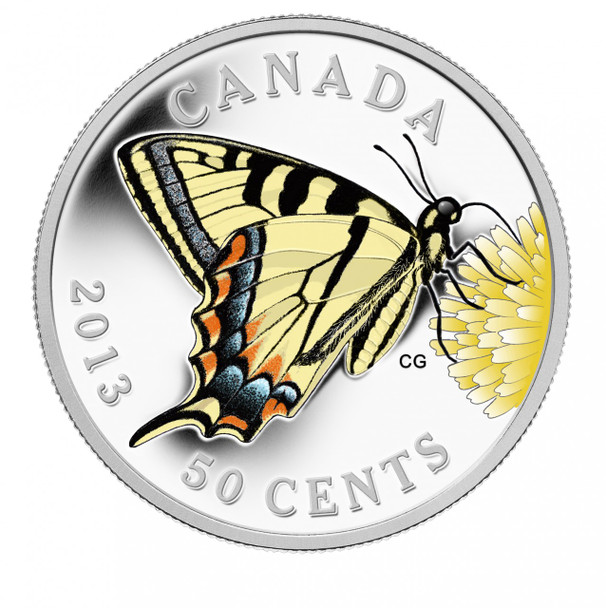Description
Theme:
Canadian Tiger Swallowtail: Harbinger of Spring
The Canadian Tiger Swallowtail (Papilio canadensis) is one of Canada’s most recognizable butterflies. With its broad wingspan of up to ten centimetres and the distinctive yellow and black tiger stripe pattern on its wings and body, the Canadian Tiger Swallowtail is a striking feature of springtime in Canada.
Description:
This silver-plated copper coin has a diameter of 42 millimetres and features selective colour. The reverse image, designed by Canadian artist Celia Godkin, depicts a colourful Canadian Tiger Swallowtail resting on a coloured dandelion (Taraxacum officinale). The reverse is engraved with the word “CANADA,” the date “2013,” and the face value of “50 CENTS.”
The obverse features the effigy of Her Majesty Queen Elizabeth II by Susanna Blunt.
Special Features:
- Be among the first to own the beautiful flagship coin from the Royal Canadian Mint’s new Butterflies of Canada series.
- An excellent addition to any collection and a striking gift for those who love butterflies, nature, and Canadian flora and fauna.
- A beautiful celebration of species that is uniquely Canadian.
- A beautiful proof finish featuring a mirrored-like background with selective colour
- Also available: a $20 Fine Silver Coin featuring a coloured engraved Tiger Swallowtail.
Product Specifications:
Face Value: 50-cent
Mintage: 20,000
Composition: silver plated
Diameter (mm): 42
Edge: Serrated
Finish: Serialized
Certificate: Serialized
Artist: Celia Godkin
Packaging:
Coin is encapsulated and presented in a Royal Canadian Mint branded maroon clamshell case lined with flock and protected by a black sleeve.
Finished Size: 88mm x 88mm
Complete Certificate text:
Canadian Tiger Swallowtail: Harbinger of Spring
The Canadian Tiger Swallowtail (Papilio canadensis) is one of Canada’s most recognizable butterflies. With its broad wingspan of up to ten centimetres and the distinctive yellow and black tiger stripe pattern on its wings and body, the Canadian Tiger Swallowtail is a striking feature of springtime in Canada.
The Swallowtail’s showiest attributes—its wings—are also its most fascinating. The name of the order for all butterflies, Lepidoptera, means scale winged and refers to the unique structure of butterfly wings, which are composed of microscopic scales layered on a thin, transparent membrane called chitin that stretches over structures that are much like veins. This wing construction, which is being studied by scientists for applications in photonics and solar heating, helps butterflies to collect solar heat as they bask in the sun. The black colouring common on the wings of many butterflies, including the Canadian Tiger Swallowtail, is also important in this process. The unique internal structure of the wing scales is responsible for the shimmering colour of many butterfly wings.
Unlike other Swallowtail species, the Canadian Tiger Swallowtail breeds only a single generation each year. Its survival mechanisms, which include exceptional camouflage, help to protect it through its various stages of life. The larvae go through several moults, with their colour at each stage adapted to camouflage them from predators. In the earliest stages, they resemble bird droppings to deter consumption by birds. By the time they are mature caterpillars, they are dark green with two spots that look like eyes on their swollen front-section, lending them an uncanny resemblance to the head of a snake. They feed only at night—a further protection. When the caterpillar does need to defend itself, the osmeterium, an organ at the back of the head that is unique to Swallowtails, releases a foul smell.
Found at the edges of hardwood forests and prevalent in flower gardens and among flowering bushes like lilac, the Canadian Tiger Swallowtail is common in all regions of Canada from mid-May to July. Its range extends from southern Canada to the Arctic Circle.














